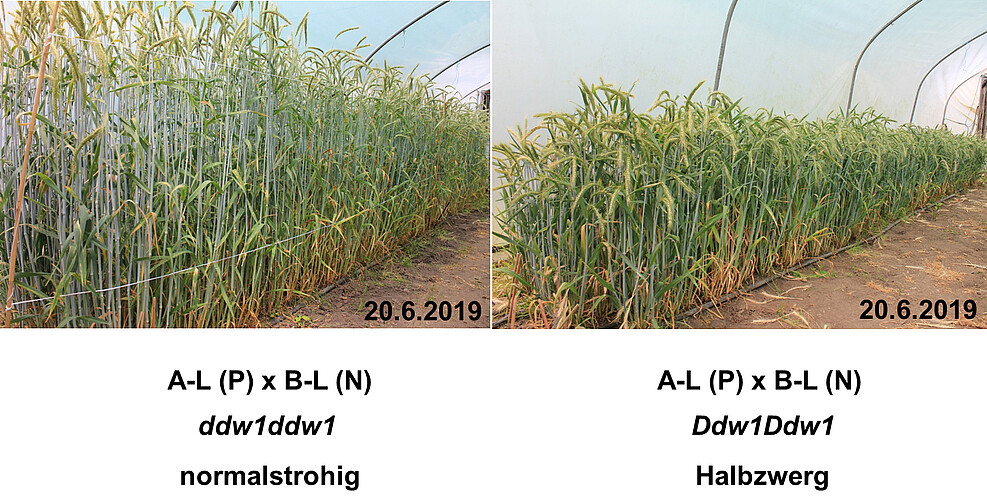Researchers of the JKI are part of an international consortium that aims to make this small grain cereal more attractive for farmers and fit for the challenges of climate change as well. A current study delivers precision tools for using the dominant dwarfing gene Ddw1 in rye breeding and conveys new insights into its mode of action.
Groß Lüsewitz/Quedlinburg. Rye cultivation has a long history in Central and Northern Europe. The various bread types made from the rather undemanding relative of wheat are very popular. An international research consortium named RYE-SUS, of which the Julius Kühn-Institute (JKI) is one of eleven partners, is seeking to develop and evaluate varieties with improved plant architecture to keep rye cultivation competitive in a changing climate. In addition to outstanding traits of rye such as winter hardiness, modest requirements on soil and the lowest carbon footprint among cereals, the RYE-SUS project aims to optimize lodging resistance and drought stress tolerance.
One of the key drivers in this field is the reduction of plant height. The researchers here trust in a breakthrough, which they describe in an article recently published in the journal “ Frontiers in Plant Science” (doi: 10.3389/fpls.2019.00857). The scientists used modern sequencing technology for a comprehensive characterization of semi-dwarf and tall rye genotypes. For the first time, they gained insight into how the growth hormone gibberellin regulates the plant height at the molecular level. The activity of a gene from gibberellin biosynthesis is significantly increased in rye carrying the dwarfing gene Ddw1. “We made use of this knowledge for the development of new selection tools. Today we are able to implement Ddw1 in elite rye germplasm with a precision that was not feasible before,” says Dr. Bernd Hackauf from the Julius Kühn-Institute.
In the middle of the 20th century, the breeding of semi-dwarf wheat led to an enormous increase in the yield, as short stems could carry much heavier ears without lodging. “We now want to initiate a similar semi-dwarf era for rye. The molecular data reveal that Ddw1 could be a key to enhancing the drought tolerance of rye as well”, says Hackauf.
Together with their partners, the scientists of the Julius Kühn-Institute succeeded in implementing the Ddw1 gene into parent lines. In summer 2019, the first semi-dwarf seed parent lines that are homozygous for the Ddw1 gene have been developed in the Pampa cytoplasm – for the first time ever. When these lines are further crossed, they inherit Ddw1 to their offspring and the stems of which remain shortened as well due to the dominance of Ddw1.
By crossing of genetically different pollen parents, the scientists can now benefit from a so-called heterosis effect: When homozygous parent lines are crossed, the vigor of the first offspring generation (F1 hybrids) usually exceeds that of their inbred parents significantly. This way, the scientists advance the 'Green Revolution' by developing particularly well performing hybrids that combine other advantageous traits in addition to the reduced height. According to the researchers' plan, the cultivation of top-performing hybrids with high ergot resistance and reduced height will in future make it possible to waive growth regulators and reduce energy costs for harvesting and post harvest grain drying. In order to be able to predict the performance of rye under different climate scenarios, the experts at JKI will establish the first growth and development model for rye as part of the RYE-SUS project. Other traits that will be investigated are the root system and the genetic and molecular basis of the outstanding winter hardiness of rye.
The project RYE-SUS has received funding from the European Union’s Horizon 2020 research and innovation programme under grant agreement No 771134.
Background
On a global scale, rye is an underutilized cereal. It contributes with less than 2.5% to the European cereal production. However, on light and drought-prone soils, for instance, rye is better suited for grain production than other cereals due to its highly developed root system. Rye is particularly affected by the effects of climate change such as drought periods, heat waves or heavy precipitations, which easily result in lodging of current standard rye varieties. The only cross pollinating small grain cereal, however, has great potential for adaptation to such environmental influences because of its rich genetic diversity. The focus in hybrid breeding has so far been to improve grain yield and rust as well as ergot resistance. Rye is used as bread grain, animal feed and renewable resource for energy production.
RYE SUS partners
- Agriculture and Agri-Food Canada, Lethbridge Research and Development Centre, Canada
- Boreal Plant Breeding Ltd, Finland
- Danko Hodowla Roślin Sp. z o.o. Zakład Hodowli Roślin Choryń, Poland
- Estonian Crop Research Institute, Jõgeva plant breeding, Estonia
- HYBRO Saatzucht GmbH & Co. KG, Germany
- Julius Kühn-Institute, Germany
- Natural Resources Institute Finland, Production systems, Finland
- Norwegian Institute of Bioeconomy, Research Dept. of Grain and Forage Seed, Norway
- Saatzucht LFS Edelhof, Austria
- Universität für Bodenkultur Wien, Austria
- University of Saskatchewan, Department of Plant Science, Canada
Reference
Braun EM, Tsvetkova N, Rotter B, Siekmann D, Schwefel K, Krezdorn N, Plieske J, Winter P, Melz G, Voylokov AV, Hackauf B (2019) Gene Expression Profiling and Fine Mapping Identifies a Gibberellin 2-Oxidase Gene Co-segregating With the Dominant Dwarfing Gene Ddw1 in Rye (Secale cereale L.). Front Plant Sci. 10:857. doi: 10.3389/fpls.2019.00857.
Contact at JKI
Dr. Bernd Hackauf
Julius Kühn-Institut (JKI)
Institute for Breeding Research on Agricultural Crops
Rudolf-Schick-Platz 3a
18190 Sanitz (Groß Lüsewitz)
Phone: +49(0)38209 45-207
E-mail: bernd.hackauf@julius-kuehn.de
Twitter: @RYE_SUS

